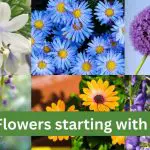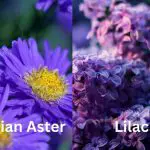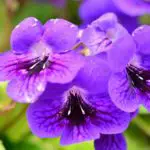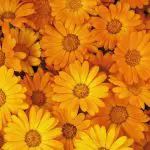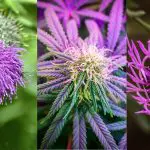Last Updated on February 21, 2023 by Derek
Brazilian Flower Names
Brazil has some of the world’s most beautiful flowers of any country in the world. The country’s diversity and extensive and notable ecosystem differences allow various types of plants and animals to exist in harmony.
According to research, Brazil holds the most extensive collection of the world’s most gorgeous and unique blooms. You can find various stunning flowers native to Brazil, though today, they grow worldwide. From Rio de Janeiro to Sao Paulo, you’ll find flower markets everywhere presenting a stunning array of South American flora.
Wild and garden flowers alike, Brazilian flowers are a beauty to behold. If you are looking for Brazilian flowering plants, below are some of the most beautiful. Some are annual, while others are perennial, meaning they come back every year.
Brazilian Consumption of Flowers
- Brazilian Jasmine (Mandevilla sanderi)
- Paperflower (Bougainvillea)
- Brazilian plume flower (Justicia carnea)
- Brazilian passion flower (Passiflora edulis)
- Common poppy (Papaver Rhoeas)
- Camelia Rose (Camellia japonica)
- Nerium oleander (Nerium Indicium)
- Red silky oak (Gravilia Banksii)
- Christmas cactus crab cactus (Sclumbergera truncata)
- Persian cyclamen (Cyclamen persicum)
Do All Passion Flowers Produce Edible Fruits?
All passion flowers do not produce edible passion fruits. Some passion fruits are toxic, but this can also happen with the edible varieties if not ripe. Ripe passion fruits will turn yellow, but some types will remain green even when mature.
Adenia Digitata is the only passion variety that is highly poisonous and unfit for consumption. It contains a mixture of a slow-acting poison that is unique to this type of passion and cyanide. Other species also contain cyanide in their vines, leaves, or unripe fruits; consuming these parts of the plant can make one sick.
On the other hand, Passiflora edulis is the most grown for fruit purposes. It bears purple and white flowers that produce an egg-shaped fruit in the shade of dark purple.
| Common Name | Botanical Name | Soil pH Range | Soil Type | Sunshine | Growing Zones |
|---|---|---|---|---|---|
| Passionfruit | Passiflora edulis | 6.5 – 7.5 | Well-draining | Full sun to partial shade | 9-11 |
Benefits of Passion Fruits
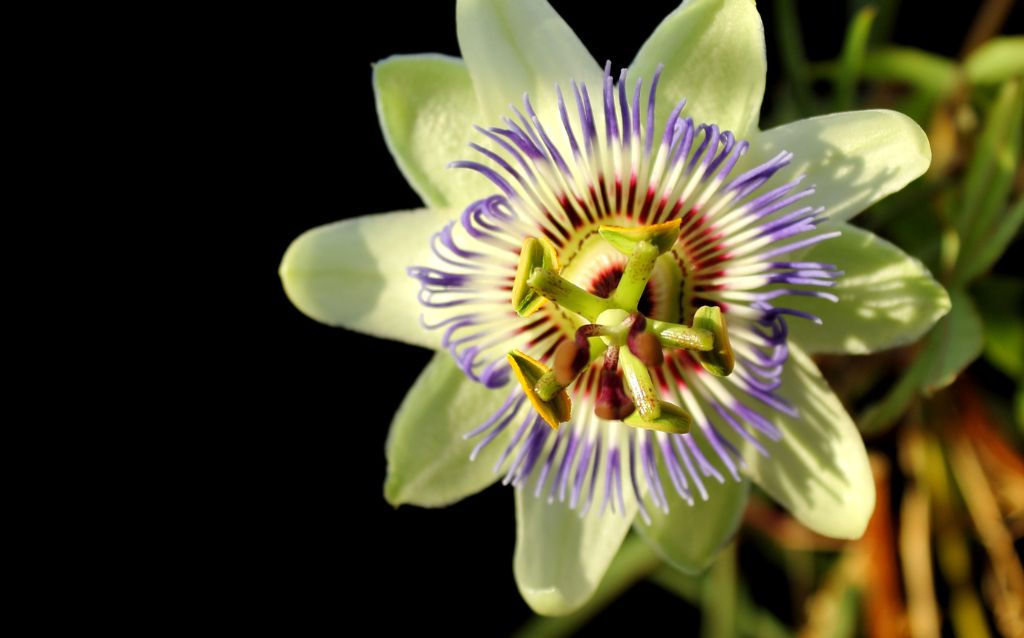
Passion fruit is scientifically proven to provide the body with essential nutrients. The following are some of the health benefits of passion fruits.
- It contains antioxidants that get rid of mobile and harmful radicals in the body
- It is a rich source of fiber
- It improves insulin sensitivity
- It is an immune booster
- It helps reduce anxiety
- It is an ideal fruit choice for diabetic people since it has a low glycemic index
Orange Tropical Flowers of Brazil
Many tropical flowers can also survive in subtropical climatic conditions. Still, others are adapted to grow in tropical climates and thrive in cold climates. Most tropical perennials, plants and shrubs can survive as annual houseplants or in northern gardens. Below are some orange tropical blooms of Brazil.
| Common name | Scientific name | Facts |
| Black-eyed Susan vine | Thunbergia alata | It produces orange blooms from summer through frost. Moss rose portulaca grandifloraNative to Brazil, moss rose produces orange flowers in summer. Other color shades include red, yellow, Rose, and white. |
| Sunset bells | Chrysothemis pulchella | It produces bright yellow blossoms with shades of red that are surrounded by permanent bright orange bracts. It blooms in mid and late summer and fall. Bromeliads Bromeliaceae generaBromeliads bloom only once a year, but when it does, the flowers last for months and sometimes a year. Its flowers come in shades of orange, red, green, or yellow. |
| Paperflower | Bougainvillea glabra | It is a long-season bloomer displaying its lovely flowers from November to May. The flowers come in orange, red, white, yellow, pink, and purple shades. |
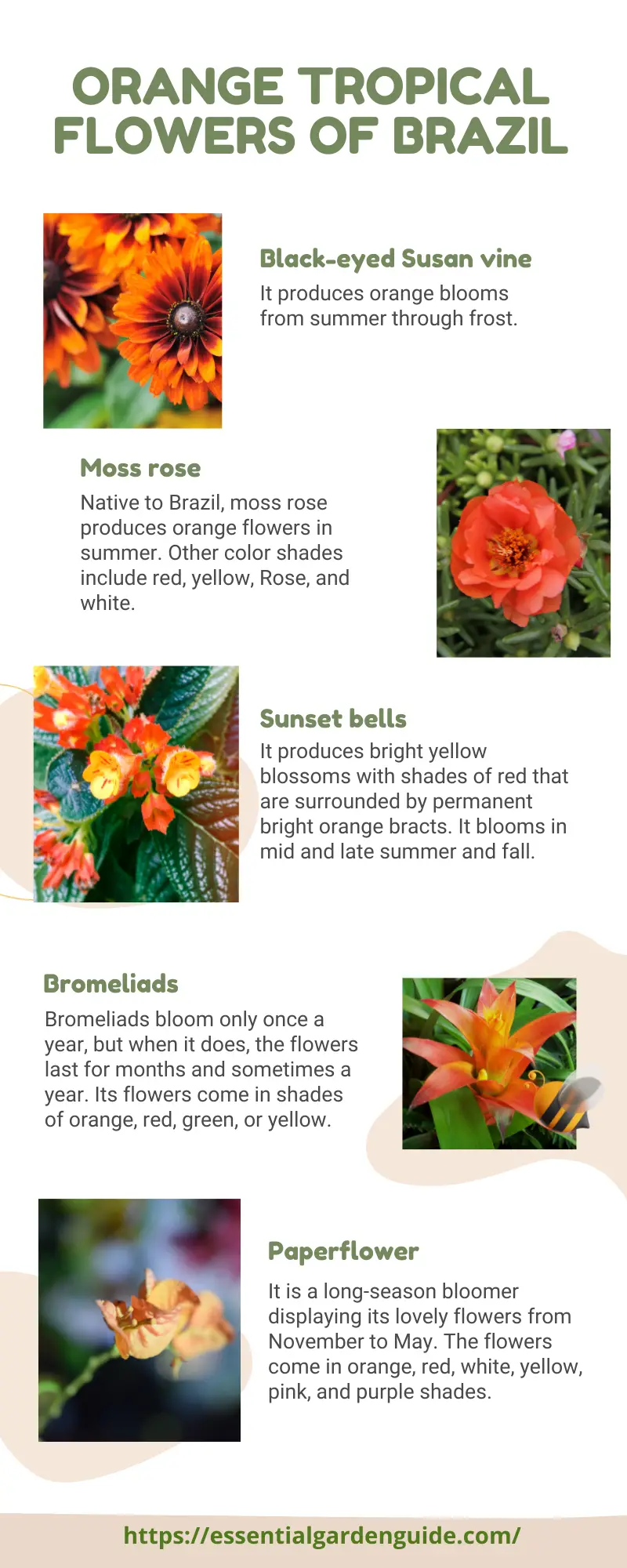
How Do You Care for Bromeliads?
The beauty of bromeliads does not only in the showy flowers but also in the fancy-looking foliage. The foliage displays gorgeous leaves in red, yellow, orange, and purple colors, sometimes with dots and stripes. They are slow growers that can take up to three years to mature and bloom.
Bromeliads bloom under particular conditions, which vary with the genus. Their bloom cycle depends on the duration of the temperature, humidity, and amount of water. They can grow as either terrestrial, growing in soil or epiphytic, supporting themselves on trees and getting nutrients from the air. Generally, bromeliads grow under the same conditions as epiphytic orchids.
| Common Name | Botanical Name | Soil pH Range | Soil Type | Sunshine | Growing Zones |
|---|---|---|---|---|---|
| Bromeliad | Bromeliaceae | 4.5 – 6.5 | Well-draining, moist | Bright, indirect light | 8-11 |
- They prefer excellently draining potting mix with an acidic pH of 5.0 to 6.0
- They need bright but indirect sunlight to flourish
- Water the plant by moistening the soil or by filling the center cup through the leaves
As much as bromeliads grow in moist tropical environments, some species are resistant to drought and grow well in drier conditions.
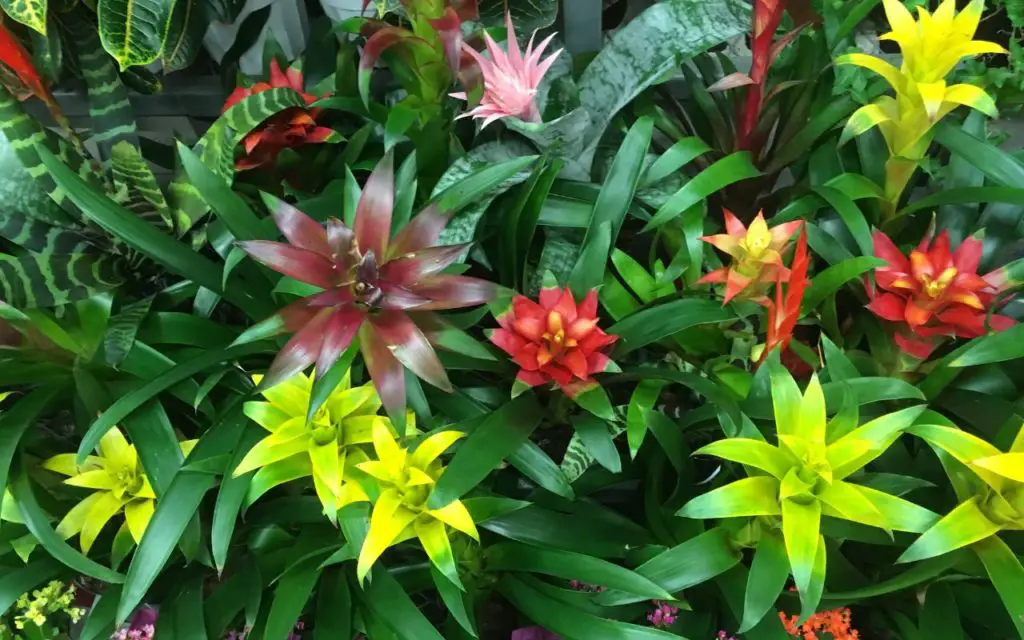
Rare Flowers in Brazil
Brazil hosts some of the rarest flowers globally, like the smelliest flower on earth that blooms in Brazil. The following are some rare flowers of Brazil.
Arrojadoa

It is a type of cacti native to the rocky habitats of Brazil. Depending on the variety, it has a thin and long upright or prostrate stem. It grows to a height of 2 meters and 5 cm in diameter. The stem has rib-like subdivisions where thorns develop. A cephalium grows on top of the stem when the plant reaches maturity. It flashes thick, red, and erect stiff hair.
| Common Name | Botanical Name | Soil pH Range | Soil Type | Sunlight | Water | Temperature | Humidity | Growing Zones |
|---|---|---|---|---|---|---|---|---|
| Arrojadoa | Arrojadoa spp. | 6.0 – 7.0 | Well-draining, rocky | Full sun | Sparse watering, drought tolerant | 60-90°F (15-32°C) | Low | 10-11 |
Drosera Quartzicola
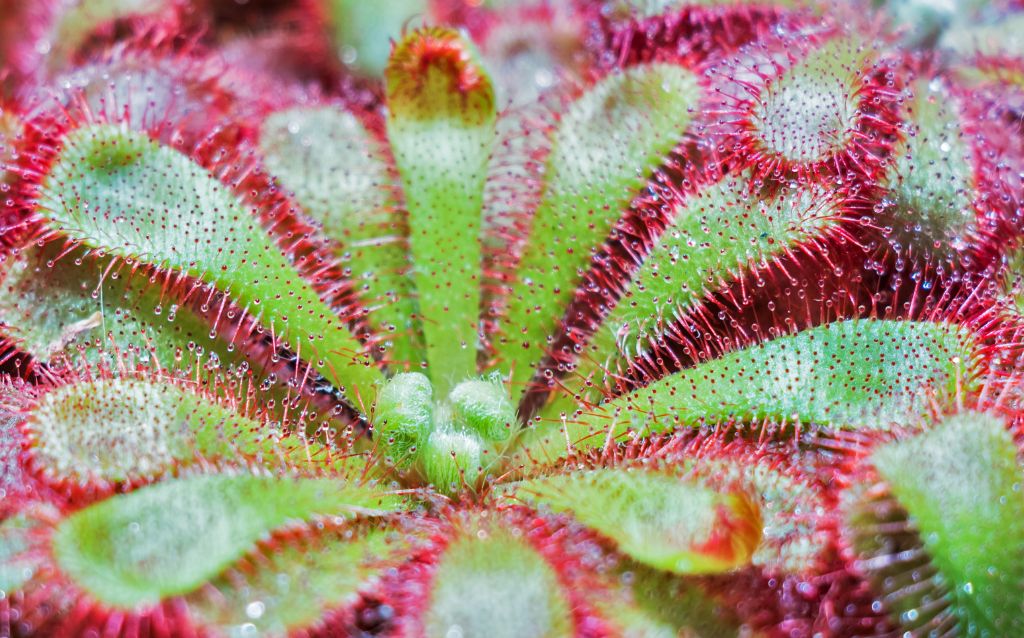
It is a critically endangered perennial herb with short stems up to 4 cm and persistent dry leaves. It belongs to the carnivorous plants genus and s endemic to Serra do Cipó in southern Brazil.
| Common Name | Botanical Name | Soil pH Range | Soil Type | Sunshine | Growing Zones |
|---|---|---|---|---|---|
| Quartz Hill Sundew | Drosera quartzicola | 4.5 – 5.5 | Peat moss, sand, perlite mix | Full sun to partial shade | 8-10 |
Titan arum
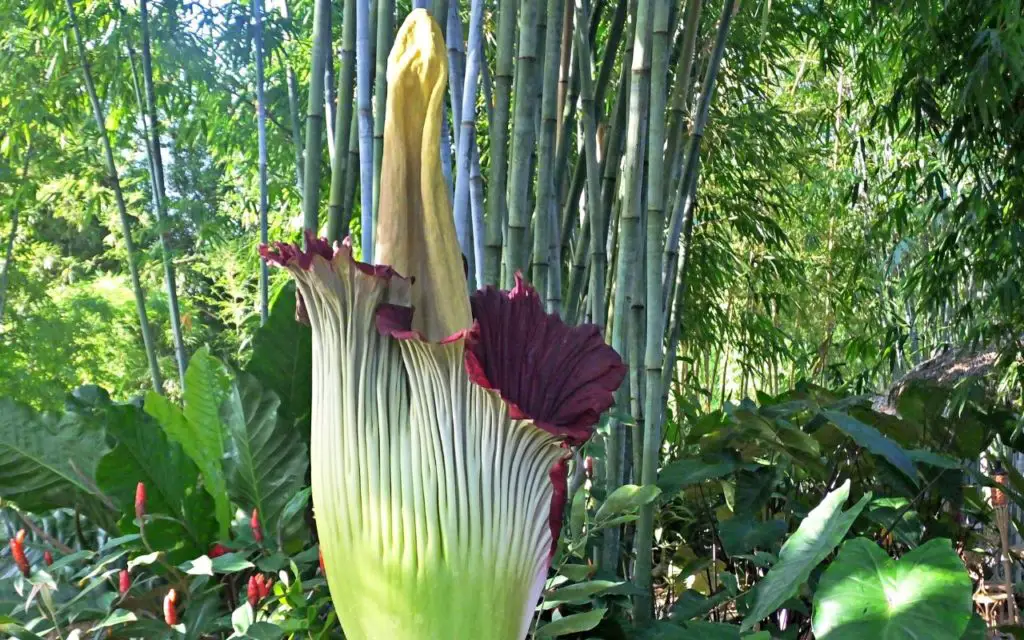
Titan arum is famous as the smelliest flower in the world, but did you know that it blooms in Brazil. Once the flower opens, it lasts for about 72 hours, releasing the smell of dead meat that attracts pollinators. It is native to the western Sumatra rainforests, and it rarely displays its flower.
| Common Name | Botanical Name | Soil pH Range | Soil Type | Sunshine | Growing Zones |
|---|---|---|---|---|---|
| Titan Arum | Amorphophallus titanum | 5.5 – 7.5 | Well-draining, loamy | Partial to full shade | 9-11 |
It is also a slow grower that can take up to six years to mature and bloom. It can grow 3 meters or taller before it blooms. In many cases, this rare flower blooms once in 10 years.
Another rare fact about this flower is that it has a similar temperature to the human body when it opens. The temperature helps in spreading the odor further. It gets global visitors to flock to southern Brazil when it is about to open.
What Plants Is Brazil Known For?
Açaí Do-Amazonas, Quinine Bark, Globe Amaranth, and Spanish Cedar Egg nut are some of the plants that give Brazil a name in the floral world. The country is famous for its abundance of plants from trees, shrubs, and bushes. Below are some popular plants in Brazil.
Mahogany Tree
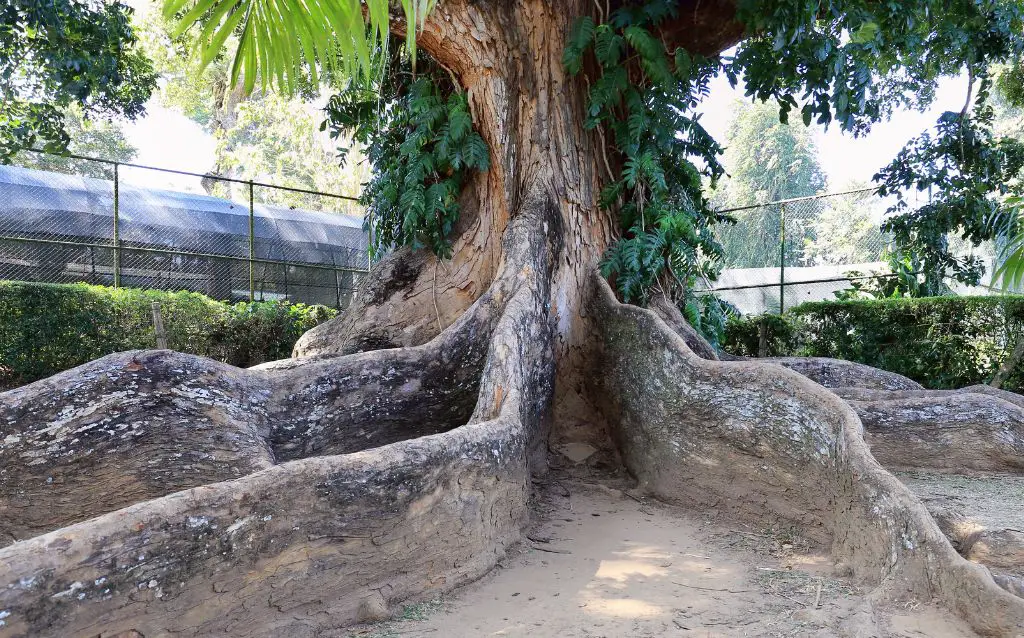
Mahogany is famous for its delicate and straight grain and the incredible lack of pockets. The trees grow best in warm climates where it blooms in spring and summer. The 5-inch-long pear-shaped flowers attract moths and bees.
| Common Name | Botanical Name | Soil pH Range | Soil Type | Sunshine | Growing Zones |
|---|---|---|---|---|---|
| Mahogany | Swietenia mahagoni or Swietenia macrophylla | 5.0 – 6.5 | Sandy, loamy | Full sun | 10-11 |
Bougainvillea

It is a tropical vine that grows 8 to 20 feet tall or more and spreads up to 10 to 40 feet depending on the cultivar. It has blue or green foliage and bears flowers in pink, purple, orange, red, white, and yellow shades. It grows best in zones 9, 10, and 11. It blooms in spring and fall and reblooms in summer. It is tolerant to drought but attracts birds.
| Common Name | Botanical Name | Soil pH Range | Soil Type | Sunshine | Growing Zones |
|---|---|---|---|---|---|
| Bougainvillea | Bougainvillea spp. | 5.5 – 6.5 | Well-draining | Full sun | 9-11 |
Tropical Water Lily
It flaunts masses of incredible flowers that are magnificently displayed above the water. The blooms can only be white, blue, magenta, pink, or yellow. Some species have a unique bi-color combination of orange, green, yellow, and peach. These lilies bloom all year in regions free from frost. In cooler climates, they display flowers in summer and sometimes in fall.
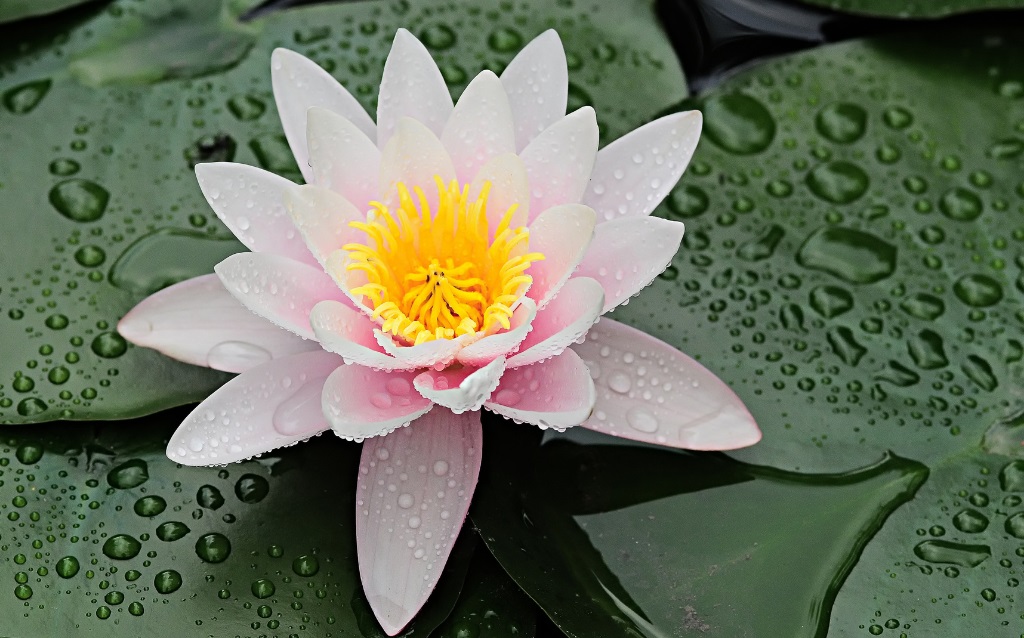
| Common Name | Botanical Name | Soil pH Range | Soil Type | Sunshine | Water Depth | USDA Hardiness Zones |
|---|---|---|---|---|---|---|
| Tropical Water Lily | Nymphaea spp. | 6.0 – 7.5 | Loamy or clay | Full sun | 6-18 inches | 9-11 |
Brazil Nut Tree
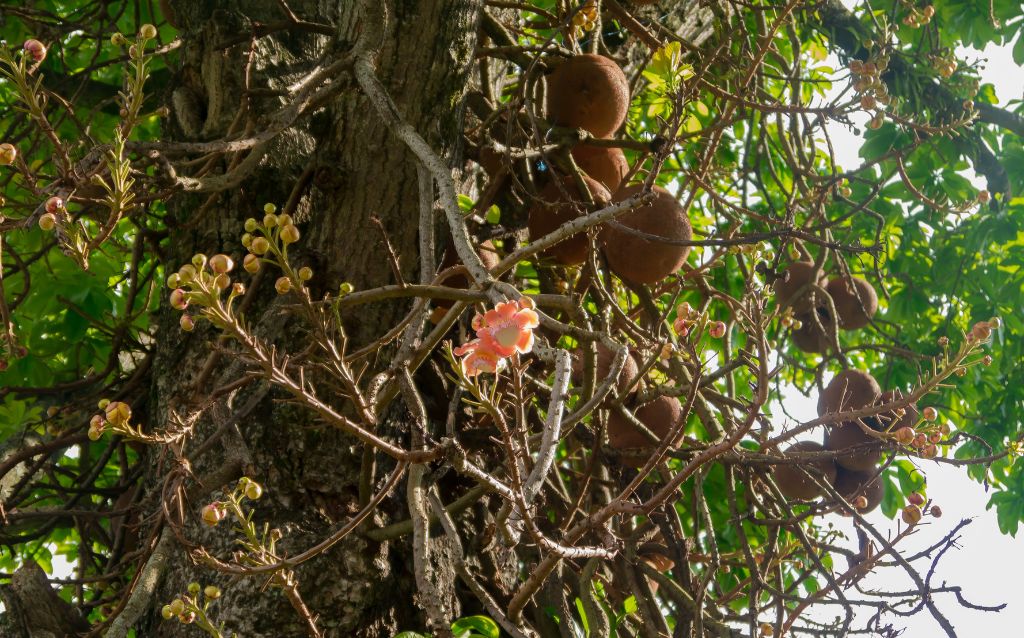
It can grow about 49 meters tall and 1.8 meters across and live as long as 500 years or longer. It is a deciduous tree with smooth and grey bark. Each of its flowers contains deciduous calyx and six cream petals.
After pollination, the flower takes about 14 months for the fruit to mature. The fruit is 4 to 6 inches across and 2.3 kg heavy.
Orchids
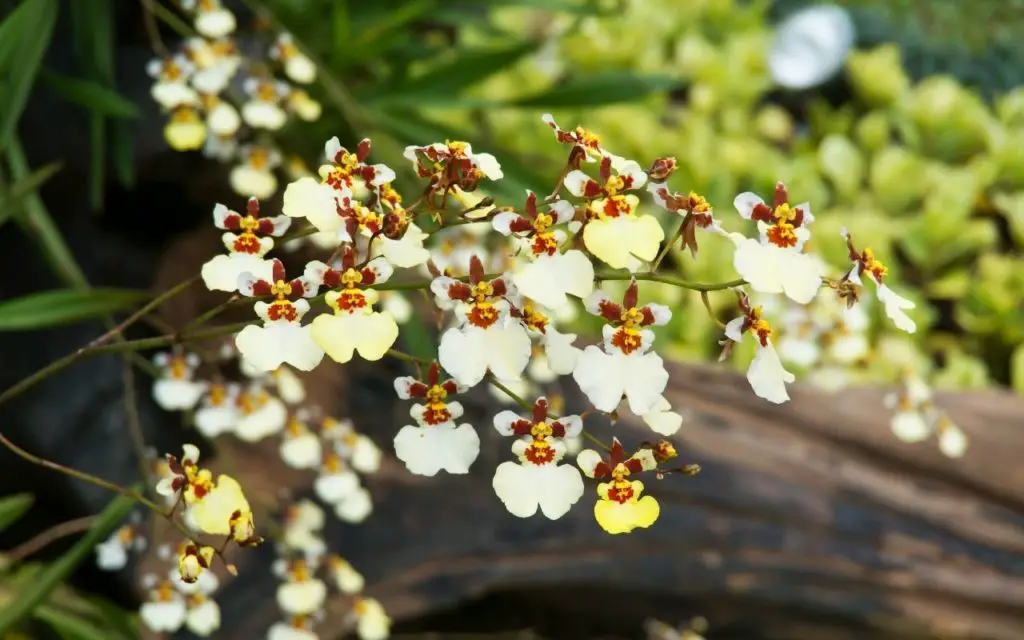
Brazilian native orchids are primarily epiphytic, meaning they grow on shrubs and trees, but there are also a few terrestrial orchids. There are also lithophyte orchids; growing on rocks. These orchids are common in low-lying tropical areas with a hot and humid climate. You can also find them in interior regions with seasonally cooler and dry conditions.
| Common Name | Botanical Name | Soil pH Range | Soil Type | Sunshine | Growing Zones |
|---|---|---|---|---|---|
| Dancing Lady Orchid | Oncidium spp. | 6.0 – 7.0 | Aerated, well-draining | Bright, indirect light | 9-11 |
What Is Brazil’s National Flower?
The Ipê-amarelo (Tecoma chrysostricha) is the official national flower for Brazil. It is a tropical flower in the family of bignonias. The flowers are white with an incredible fragrance and a few varieties that produce pink and yellow blooms.
Corsage Orchid Brazil

Cattleya Iabiata is Brazilians’ favorite orchid. It is commonly called ‘corsage orchid’ since most people love wearing it to dinner and parties as a lovely accessory. It is also called the queen of orchids.
| Common Name | Botanical Name | Soil pH Range | Soil Type | Sunshine | Growing Zones |
|---|---|---|---|---|---|
| Cattleya | Cattleya Iabita | 6.0 – 7.0 | Well-draining | Bright, indirect light | 10-11 |
It is an epiphytic orchid native to northeastern Brazil, particularly the mountainous forests. It has various types, all with different colors. Some of them include Cattleya Labiata Rubra and Cattleya Labiata Semi-alba. Its flowers are among the largest in all cattleya species, and they also have a unique shape. It goes by several common names. Below are some of them.
- Crimson cattleya
- Ruby-Lipped cattleya
- Brazilian cattleya
Brazilian cattleya grows on large tree trunks and branches in spots with partial shade and partial sun. It can exist as a lithophyte sometime, growing on rocks.
Video roundup for Brazilian plants and flowers
Other notable Brazilian plants and flowers

Brazil button flower is a perennial that can grow up to 18 inches, spreading for about 24 inches. While classed as hardy plants, a slight frost can kill them and depends on the longevity of below freezing temperatures.
The leaves are olive-green colored, have serrated edges. They are deer and rabbit resistant.
| Common Name | Botanical Name | Soil pH Range | Soil Type | Sunshine | Growing Zones |
|---|---|---|---|---|---|
| Brazil Button Flower | Centratherum intermedium | 6.0 – 7.5 | Well-draining, sandy or loamy | Full sun | 9-11 |
Brazilian red cloak plant
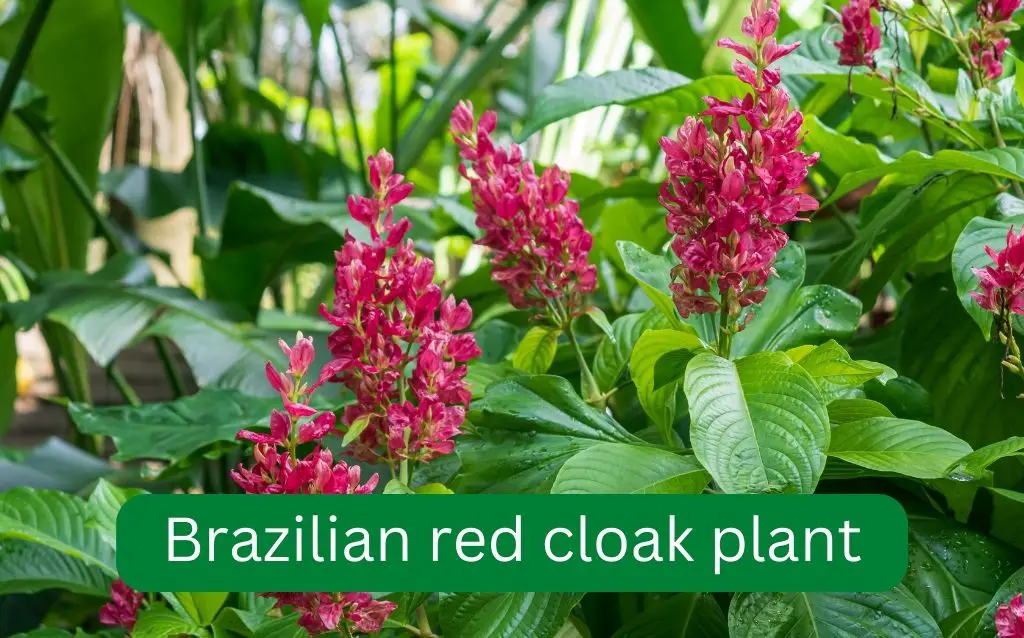
| Common Name | Brazilian cloak bush |
| Botanical Name | Megaskepasma erythrochlamysspp. |
| Family | Acanthaceae |
| Plant Type | Shrub |
| Mature Size | 7 ft. tall, 6 ft. wide |
| Sun Exposure | Part-sun |
| Soil Type | Rich, well-drained soil |
| When does it bloom? | Year round |
| Flower Color | White with red bracts |
Brazilian rape flower

FAQ relating to Brazilian flowering plants
Where in Brazil are Rio de Janeiro and eastern Brazil?
What is the passion fruit, and how is it used in Brazilian flower arrangements?
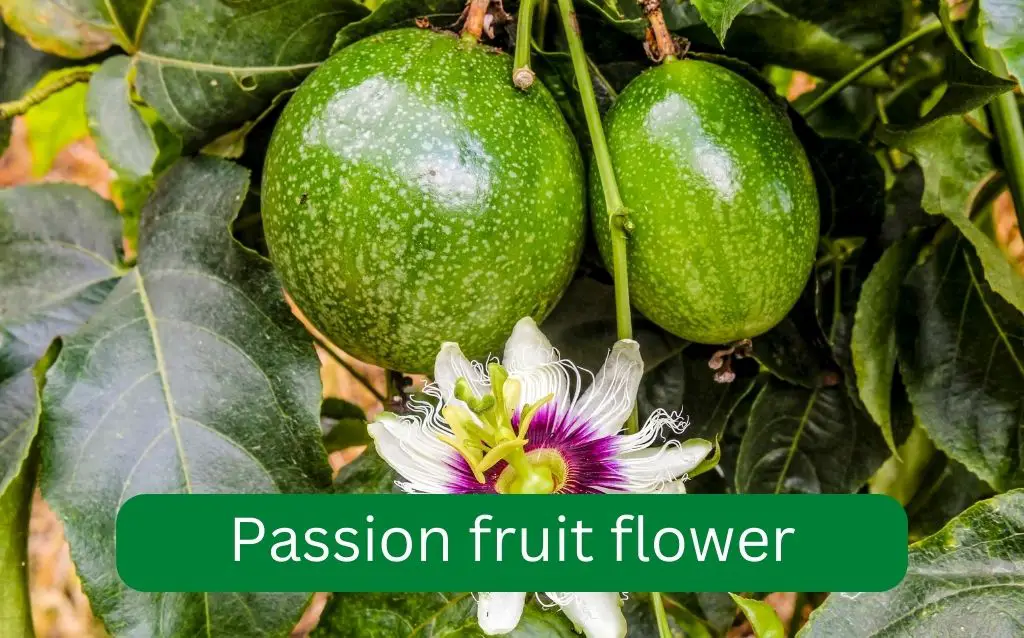
Which perennial plants are also considered Brazilian flowers?
- Verbena x hybrida ‘Homestead Purple’
- Vinca minor ‘Bowles’
- Brazilian Blue Buttonbush
- Corsage Orchid
- Brazillian Bellflower
- Brasilian jasmine
What impact does the growing of Brazilian flowers have on the environment?
It isn’t so much the impact of growing flowers on the environment, but the absence of growing flowers that causes harm. You don’t have to develop a complex theory, but it stands to reason that plants breathe out oxygen and use carbon dioxide to live.
Human beings have the exact opposite, so we have a symbiotic relationship of sorts. We need more flowers, trees and plants to flourish. However, it’s a bit one-sided in that plants don’t need us at all to survive, as CO2 is generated by dying plant material.

